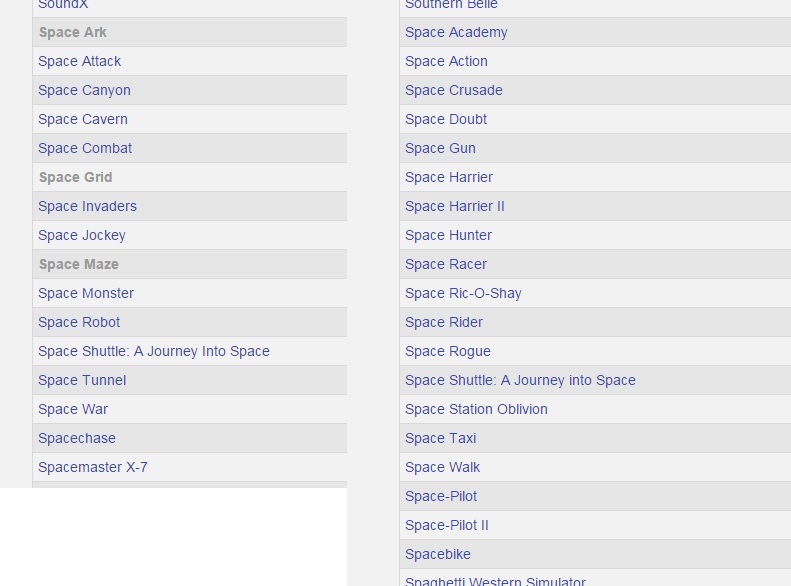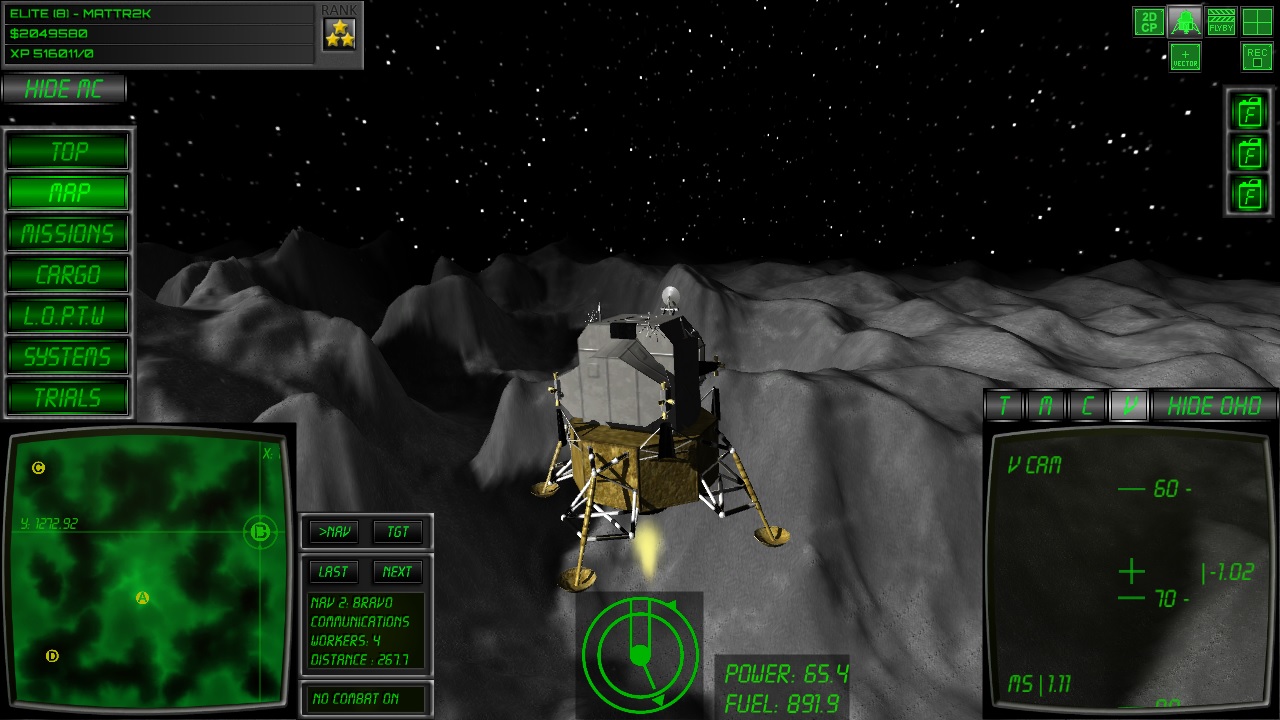Sounds like a game I would really suck at being as clumsy as I am. Good review though.
Review: Lunar Flight (Steam)
|
|
On 02/18/2016 at 07:29 PM by Matt R See More From This User » |
As long as video games have been around, man has looked to the stars and wondered how to continue his proclivity for war, conquest, enslavement, and exploitation from the comfort of his own living room.

Atari 2600 (left) and Commodore 64 (right) were all about the space
Our love for laser blasting, robot smashing, and alien deporting has only grown in the last three decades (no thanks to Obama) in new and exciting time-sucking ways: open-universe sandbox games, such as Elite: Dangerous, or procedurally-generated, top-down strategy games, like FTL. Lunar Flight is not about epic space battles or space hippies trying to make peace with gnarly-forehead dudes holding space swords in the distant future; it is a simple lunar module simulator well worth its $10 price. I got it on sale for $4, which was \o/.
That low price point should not imply a low quality. Lunar Flight is a perfect, utopian vision for video games that all developers should emulate. Only a few seconds of loading stands between the bootup screen and a choice between three mission types: delivering cargo to another base, locating cargo and returning to base, and performing a simple reconnaissance (hovering in a small target area for a few seconds), then returning to base. When one is complete, experience points and a monetary reward is shown in a retro, boxy menu with green LED text, then you pick which mission you want to do next, save/discard the instant replay, and that is all. If you crash, there’s a $3,500 penalty but you’ll immediately be placed at one of the bases to pick another mission within seconds. Imagine no cutscenes. It's easy if you try.
Now for the hard part: everything else. As in any realistic simulator, it’s not the flying that’s hard—it’s the landing. Ok, the flying part is pretty hard too. I lied. It’s tough. All of it. Every thrust must be done deliberately. Velocity, distance to the base, altitude, relative heading, pitch, and fuel consumption must be accounted for at all times.
The instrumentation has every necessary bit of readout data in a pleasing layout, as can be expected from a sim. One of the ship’s monitors shows the projected landing area based on the module’s velocity and tracks a ‘+’ on the exact spot. Another monitor automatically switches from the map to a top-down view when directly above a moon base. In addition, the realistic altitude warning alarm is, appropriately, the most harrowing sound imaginable. As you can see below, it will be best to watch all of the instructional videos before beginning, since the sensory overload can be quite overwhelming:

The lunar module is, of course, a primitive and delicate machine. Everything is controlled manually, for better or worse. A non-crash landing all but requires the relative speed to be below ~1 unit and no greater than .5 units in descent speed; if it’s even slightly over, the module will take severe damage, and going too far over those levels may send it bouncing off the landing pad and into a crash. I can’t tell you how many times I’ve hopped and bounced towards the base at only a few meters high, bumped into the edge of the landing pad (or one of the nearby towers) and tipped the module over on its side and ran out of fuel—while still on the pad! I wish that aspect was a little more forgiving. Can’t they hook up the fuel pump even if it’s not perfectly standing? Ah well. At least the replays are a nice way to help take the sting out of frustrating crashes.
Here’s an ugly crash landing. Technically, I ended up ON the landing pad, but it was not standing upright, and thus, a failure. My velocity was 1.4 units and descent velocity was under 1.0 units upon touchdown, yet even that was too fast:
The first map is pretty small and the environment relatively flat. The true challenge, especially at the beginning, is from the touchy (pre-upgrade) controls and understanding the liftoff power-to-weight ratios. Lunar Flight has a nifty cruise control feature called the thrust lock which can keep the ship at a certain altitude with just a press of the Ctrl button. By locking the thrust power at the liftoff power-to-weight ratio of the on-board cargo while the module is in a neutral descent and the nose perfectly level, you can free up some time to wander away from the computer to make a cup of Tang or scream at Tom Hanks about the GD gimbals.
A disastrous roll like this can be corrected--with enough skill and luck.
In keeping with Lunar Flight’s love of fours (four maps, four moon bases in each, and, presumably, there are four lights), there are four upgradable parts: thrust power, stabilizer, fuel, and thruster jets, which can be permanently upgraded with the money awarded after each successful mission. There are also four slots for single-use extras, such as a tank of fuel, repair (to stop fuel leaks following a crash landing), boost (for greater thrust power), or gyro improvement. The cash rewards for each mission range from $1,250 for a small delivery to $10k and up for a recovery mission. Of course, when you first start, you will not have the money to buy anything for a while (again I blame Obama).
For me, the lost cargo missions are the ultimate tests of a pilot’s skill. When selecting this mission type, the player is only given a compass direction relative to one of the bases, but not the cargo’s distance. So you just have to fly in that direction and hope it’s resting in a flat area instead of, say, the ledge of a mountaintop. The only hint that you’re getting close is a transponder beep and a blinking light on the instrument panel. It’s challenging enough to find a gray box amidst a sea of gray on the first map and return with the limited fuel available, but in the latter three maps full of rolling hills surrounded by deep canyons and moon bases stretched farther and farther apart, the placement of the cargo becomes downright insidious. Sometimes they will require a landing halfway down a curving foothill at a 45-degree angle level. Insidious, yes, but with practice, even this skillful maneuvering can become routine.
Lunar Flight is a deep simulator with a steep difficulty curve that will take (full) days of practice to overcome, but when that day comes, it is immensely satisfying. It truly captures the unforgiving nature of low-gravity flight as well as the exhilaration and drama of a successful touchdown. The fourth map is astounding and will require a complete re-learning (I’m not going to explain. Just get this game). Four years (there it is again!) on from its release, it has only gotten better: in the last few weeks the developer has added a new, three-dimensional cockpit view with dynamic lighting. I’ll bet it looks spectacular with the Oculus Rift headset. For only $10, the sublime experience of realistic lunar flight from the comfort of your living room should not be missed.
In your face, Nolan Bushnell.




Comments